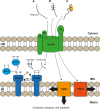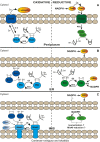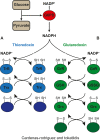Cytosolic redox components regulate protein homeostasis via additional localisation in the mitochondrial intermembrane space
- PMID: 28746987
- PMCID: PMC5601281
- DOI: 10.1002/1873-3468.12766
Cytosolic redox components regulate protein homeostasis via additional localisation in the mitochondrial intermembrane space
Abstract
Oxidative protein folding is confined to the bacterial periplasm, endoplasmic reticulum and the mitochondrial intermembrane space. Maintaining a redox balance requires the presence of reductive pathways. The major thiol-reducing pathways engage the thioredoxin and the glutaredoxin systems which are involved in removal of oxidants, protein proofreading and folding. Alterations in redox balance likely affect the flux of these redox pathways and are related to ageing and diseases such as neurodegenerative disorders and cancer. Here, we first review the well-studied oxidative and reductive processes in the bacterial periplasm and the endoplasmic reticulum, and then discuss the less understood process in the mitochondrial intermembrane space, highlighting its importance for the proper function of the cell.
Keywords: mitochondria; oxidative folding; reductive pathways.
© 2017 The Authors. FEBS Letters published by John Wiley & Sons Ltd on behalf of Federation of European Biochemical Societies.
Figures



Similar articles
-
Balancing oxidative protein folding: the influences of reducing pathways on disulfide bond formation.Biochim Biophys Acta. 2014 Aug;1844(8):1383-90. doi: 10.1016/j.bbapap.2014.02.004. Epub 2014 Feb 15. Biochim Biophys Acta. 2014. PMID: 24534645 Review.
-
The MIA pathway: a tight bond between protein transport and oxidative folding in mitochondria.Biochim Biophys Acta. 2012 Jul;1823(7):1142-50. doi: 10.1016/j.bbamcr.2012.04.014. Epub 2012 May 2. Biochim Biophys Acta. 2012. PMID: 22579494 Review.
-
Oxidative protein biogenesis and redox regulation in the mitochondrial intermembrane space.Cell Tissue Res. 2017 Jan;367(1):43-57. doi: 10.1007/s00441-016-2488-5. Epub 2016 Sep 8. Cell Tissue Res. 2017. PMID: 27632163 Free PMC article. Review.
-
Redox regulation of protein folding in the mitochondrial intermembrane space.Biochim Biophys Acta. 2009 Jan;1793(1):139-45. doi: 10.1016/j.bbamcr.2008.08.002. Epub 2008 Aug 13. Biochim Biophys Acta. 2009. PMID: 18761382 Free PMC article. Review.
-
Three approaches to one problem: protein folding in the periplasm, the endoplasmic reticulum, and the intermembrane space.Antioxid Redox Signal. 2014 Jul 20;21(3):438-56. doi: 10.1089/ars.2014.5841. Epub 2014 Mar 6. Antioxid Redox Signal. 2014. PMID: 24483706 Review.
Cited by
-
The mitochondrial intermembrane space: the most constricted mitochondrial sub-compartment with the largest variety of protein import pathways.Open Biol. 2021 Mar;11(3):210002. doi: 10.1098/rsob.210002. Epub 2021 Mar 10. Open Biol. 2021. PMID: 33715390 Free PMC article. Review.
-
Redox-Mediated Regulation of Mitochondrial Biogenesis, Dynamics, and Respiratory Chain Assembly in Yeast and Human Cells.Front Cell Dev Biol. 2021 Sep 7;9:720656. doi: 10.3389/fcell.2021.720656. eCollection 2021. Front Cell Dev Biol. 2021. PMID: 34557489 Free PMC article. Review.
-
The Mia40/CHCHD4 Oxidative Folding System: Redox Regulation and Signaling in the Mitochondrial Intermembrane Space.Antioxidants (Basel). 2021 Apr 12;10(4):592. doi: 10.3390/antiox10040592. Antioxidants (Basel). 2021. PMID: 33921425 Free PMC article. Review.
-
Protein import in mitochondria biogenesis: guided by targeting signals and sustained by dedicated chaperones.RSC Adv. 2021 Oct 1;11(51):32476-32493. doi: 10.1039/d1ra04497d. eCollection 2021 Sep 27. RSC Adv. 2021. PMID: 35495482 Free PMC article. Review.
-
Endosymbiotic selective pressure at the origin of eukaryotic cell biology.Elife. 2022 Nov 10;11:e81033. doi: 10.7554/eLife.81033. Elife. 2022. PMID: 36355038 Free PMC article. Review.
References
-
- Schafer FQ and Buettner GR (2001) Redox environment of the cell as viewed through the redox state of the glutathione disulfide/glutathione couple. Free Radic Biol Med 30, 1191–1212. - PubMed
-
- Sundaresan M, Yu ZX, Ferrans VJ, Irani K and Finkel T (1995) Requirement for generation of H2O2 for platelet‐derived growth factor signal transduction. Science 270, 296–299. - PubMed
-
- Kamiński MM, Röth D, Krammer PH and Gülow K (2013) Mitochondria as oxidative signaling organelles in T‐cell activation: physiological role and pathological implications. Arch Immunol Ther Exp (Warsz) 61, 367–384. - PubMed
Publication types
MeSH terms
Substances
Grants and funding
LinkOut - more resources
Full Text Sources
Other Literature Sources

